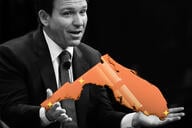You have /5 articles left.
Sign up for a free account or log in.
WASHINGTON -- College enrollments and degree completion will continue to boom for the rest of this decade, but who enrolls (and finishes) will vary widely and, without a major change, far too few Americans will complete college to achieve the ambitious goals that President Obama and others have set for the country.
Those are among the conclusions that might be drawn from a series of projections on educational attainment that the U.S. Education Department released on Wednesday. The report by the National Center for Education Statistics, "Projections of Education Statistics Through 2019," looks out (with full acknowledgment of the limitations of the crystal-ball gazing) at how everything from first grade enrollments through doctoral awards might look at the end of the current decade.
For colleges and universities, the news is mixed. As widely anticipated, high school enrollments will flatten; after growing 27 percent between 1994-95 and 2006-7, the number of high school graduates will have grown by just 1 percent from 2006-7 through 2018-19. Twenty-three states and the District of Columbia will see increases in that time, and 27 project declines.
Postsecondary enrollments will increase nonetheless, the department projects, rising 17 percent, to 22.4 million students, from 2008 through 2019. The flattening in the number of high school graduates will be more than offset, the analysis speculates, by sharp jumps in the number of 25- to 29-year-olds. While that age cohort made up 14.3 percent of all enrollments in 2008, 25- to 29-year-olds will make up 15.3 percent of all students by 2019, the department projects. The overall enrollment increase, while sizable, would actually represent a slowing pace, as total enrollments grew by 34 percent in the period from 1994 to 2008, the analysis shows.
The age of who enrolls would not be the only factor to change meaningfully under the federal projection. While the numbers of full-time and part-time students would increase at the same rate (17 percent) between 2008 and 2019, the analysis finds, the rate of increase for Hispanic and Latino enrollments (45 percent) would greatly outpace those of other racial groups -- 30 percent for black and Asian/Pacific Islander students, 7 percent for white students, and 5 percent for American Indian or Alaska Native students.
And the gender gap, already a concern for many in higher education, would widen: with enrollments of women growing by 21 percent and men by just 12 percent, as the department projects, by 2019 women would make up 59 percent of all postsecondary students, up from the current 57.1 percent.
(One piece of potentially interesting information that cannot be gleaned from the current report is whether the government expects the recent growth of for-profit colleges to continue. The report lumps for-profit and private nonprofit colleges together in a "private" category, and projects that those institutions will see a slight decline between 2008 and 2019 [to 26.4 from 26.9] in the percentage of all students they enroll. William Hussar, an economist at the statistics center, said via e-mail that its officials did not believe that their statistical models were "adequately capturing the historic trends of the data" on for-profit enrollments, so "we decided not to include these projections.")
The best news in the report for colleges and universities -- and policy makers concerned about increasing postsecondary attainment -- is that it projects the number of degrees conferred to rise sharply. Under the government's analysis, American colleges and universities would award significantly more of all types of degrees, as seen in the table below:
Postsecondary Degrees Conferred, Actual and Projected
| 2007-8 (actual) | 2019-20 (projected) | % change | |
| Associate | 750,164 | 975,000 | 30.0% |
| Bachelor's | 1,563,069 | 1,926,000 | 23.2% |
| Master's | 625,023 | 839,000 | 34.2% |
| Doctoral | 63,712 | 97,900 | 53.7% |
| First Professional | 91,309 | 121,900 | 33.5% |
But those increases, while sizable, are almost certainly insufficient to reach the ambitious college completion goals that President Obama, along with several leading foundations and a veritable chorus of nonprofit groups, have embraced as a national higher education strategy. Groups like the National Center for Higher Education Management Systems have said that the attainment rate needs to grow by about 4.5 percent a year to reach the degree attainment rate of roughly 60 percent of 25- to 34-year-olds having a meaningful college credential. The rate projected by the department, of roughly 25 percent over 12 years, does not come close.
Dewayne Matthews, vice president for policy and strategy of the Lumina Foundation for Education, conceded that the numbers as presented suggest a steep hill to climb for the completion goals that his group and others have championed. But he said the data are unlikely to have captured several factors that are likely to push college-credential-attainment numbers higher, including intensified interest in the awarding of work force-relevant certificates, the boom in college enrollments in the last three years (only some of which, Matthews said, is directly related to the recession), and recent sharp rises in Latino enrollments.
If colleges and universities can capitalize on those rising enrollments by ensuring that a higher proportion of the students they enroll leave with meaningful credentials, the attainment goals may be within reach after all, Matthews said. "You have this benefit of lots of people now going to college, including underrepresented students," he said. "If we could in fact get more degree yield out of those people, by making real progress on completion, we could get double benefit."





